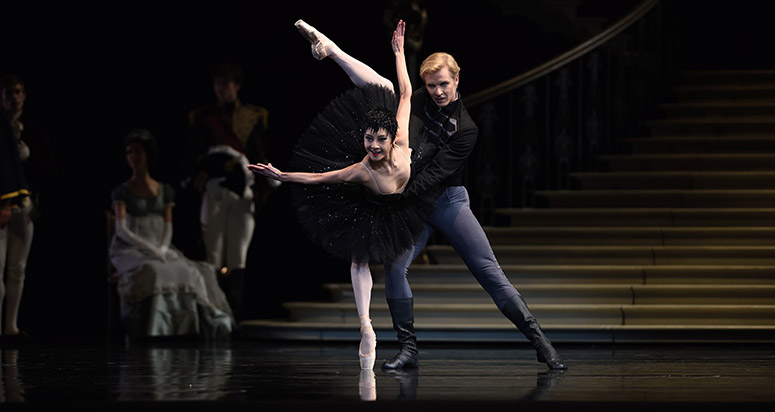One of the more progressive and generous gestures made by the San Francisco Ballet (SFB) is its Pointes of View Lecture Series, which features company artists and visiting scholars meeting with ballet fans for an early-evening dialogue about the trends and innovations in company performances.

Yuan Yuan Tan and Tiit Helimets in Tomassonís Swan Lake (Erik Tomasson)
By Paul Duclos
Published: March, 2016
Dance educator Mary Wood has interviewed ballet master Felipe Diaz and principal dancer Lorena Feijoo on the World Premiere of Liam Scarlett’s Fearful Symmetries, as well as ballet master Katita Waldo and artists from the company to discuss William Forsythe and his unique approach to contemporary ballet.
Here in an exclusive Bay Crossings interview, Ms. Wood shares a few poignant insights.
Bay Crossings: How do you prepare for these interviews?
Mary Wood: First, I familiarize myself with the context—if I’m interviewing a choreographer, I try to find out as much as possible about the work, and about its music/composer. Then I find any biographical information about the people with whom I’ll be in conversation. If it’s a historical subject (Swan Lake, Giselle, etc.) I review the history of the piece and its period. It’s fun to try to find nuggets that haven’t appeared in the program notes or press releases! Then I devise a bullet-point list of topics to cover—I rarely prepare set questions, because I’d rather that the tone be more conversational.
BC: Are some more challenging than others?
Wood: Of course. If I don’t know my guest(s) or have never spoken with them, I “over-prepare” lists of topics or questions (despite what I said above) because I don’t know how they’ll respond. The worst guest is the one who answers a question in a few words and then looks expectantly at me, waiting for the next. Another challenging guest is one who launches into a soliloquy, summarizing every topic I’ve prepared, and then runs down, leaving me with nothing more to ask!
BC: Who are the easiest guests?
Wood: The easiest guests are, not surprisingly, ones I know, and I can trust them to take a cue and run with it entertainingly and informatively. I have recently observed that most of the currently popular, youngish choreographers are wonderfully thoughtful and articulate. That’s a treat!
BC: Can you address any challenges?
Wood: It can be a challenge if the material is all new to me, because I have to spend a lot of time on research. On the other hand, it’s easy to come up with interview points, because I genuinely want to know more about it.
BC: Have you ever been surprised by some of the responses?
Wood: Sometimes I’ve been more delighted than surprised, I think, by a guest, usually a younger corps dancer, who is well-informed and articulate. The interview turns out to be easy, when I’d feared I would have to really work for responses!
BC: What should the audience take away from these talks?
Wood: My goal is always to create a better-informed, more appreciative audience. So, I want them to know more about the choreographer, the dancer, the composer; more about choreography, about music; more about ballet history, and more about the innovations we’re experiencing in our art form. They’re bound to understand and to enjoy what they see so much more.
BC: Anything the audience should do to prepare?
Wood: I’d love it if the audience would read the program notes—they’re excellent, and I often refer to them. And do some simple googling of the guests who have been advertised. It would be wonderful if folks would come with a list of questions, and then ask any that weren’t answered during the conversation during our Q & A.
BC: Finally, how did you come up with this concept?
Wood: The Pointes of View series is an evolutionary product of an earlier series of pre-performance programs sponsored for well over 50 years by the Junior League of San Francisco. When the SFB took over the sponsorship, we wisely didn’t tinker with what had been pretty successful—a bit of information imparted, some visuals, an interview.
Follow Paul Duclos’ Cultural Currents online with his blog at: paulduclosonsanfranciscoculture.blogspot.com

